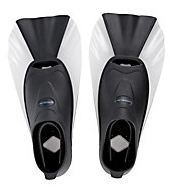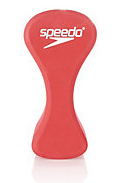With so many elements to think about when swimming up and down, from preventing your legs from sinking to perfecting your breathing pattern, heading in a straight line may become a bigger feat than expected.
Nobody wants to waste time and effort zig-zagging across the pool so how do you make sure you’re swimming in a straight line? The starting point is in maintaining a good body position.
BODY POSITION
Goggles are an essential piece of kit for anyone who wishes to maintain good position. With your face in the water, keep your eyes fixed on a point down and slightly forward.
Your head should fall into line with the natural position of your spine – imagine you have a rod through it, preventing you from putting your head up any further. If your hips drop, your smooth, straight body position will be lost.
A still, well-positioned head is the key to swimming straight. If you throw your head from side to side while swimming your body will be thrown off balance and you are likely to become quite disorientated too! However, learning to the correct rhythm of breathing is notoriously difficult.
First, the stroke must be broken down into smaller parts. Olympic coach Ben Titley, who trains the likes of Fran Halsall and Liam Tancock at the British Gas ITC Loughborough, provides us with tips from the top.
- When swimming freestyle, each hand should enter between your ear and shoulder. It may help to imagine a mirror reflecting your image on the bottom of the pool, with a line drawn down the centre. As your hand enters, it must not cross onto the opposing side of the body.
- On the same vein, as you enter the ‘pull through phase’ the hand should be kept under the body, but again, you must not pull across the centre line. This will stop your body rolling from side to side to ultimately throw you off balance. If your arms keep striding forwards, and not diagonally, your body will too.
- Using a snorkel will take breathing totally out of the stroke and you can focus on swimming in a straight line, using the bottom of the pool to guide you.
- By placing a pull buoy in between your thighs, your legs will be taken out of the equation, decreasing resistance and drawing your hips up to the surface. It gives you a chance to focus purely on your arms. For anyone slightly more advanced, or wishing to push themselves, a pull buoy can be placed between the ankles. The core is forced to switch on given that everything in between the lungs and buoy (which like to float!) wants to sink.
- If you have been maintaining a straight body with a snorkel, attempt it without after a while and monitor your progression.
- To keep a still head on backstroke, use a buoy to take weight off legs and draw hips up to the surface, and do double arm backstroke. This will prevent you worrying about arm position and allow you to simply swim straight.
Once you’re feeling confident about your body position and your head in the water, it’s time for some drills to improve your direction. Ben talks us through four of the best:
DRILL 1: FINS

- For relatively advanced swimmers, fins may be used to kick without a board.
- To begin with, keep one arm extended ahead and the other arm by your side, then swap. Again, use a snorkel, or keep your mouth out of water (so you’re almost on your side) but look where you are going (slightly forward and down).
- If you are slightly more confident, breathing techniques can be practiced simultaneously.
DRILL 2: KICKING
- Isolating your kick is also beneficial for backstroke.
- This time, using fins, do flutter kick on your back. After doing this for a few lengths, begin rotating your body gently from side to side while keeping your head fixed. This will be your body’s natural motion when your arms are added.
- If even more advanced, to increase stability, enabling you to swim in a straight line, use one fin & one paddle (on alternate arms/legs) while swimming freestyle. This will test your body balance.
DRILL 3: FLOATING
- Floating drills may also be done to create good body position before applying it to the stroke.
- Place a pull buoy between your thighs or place at ankles and drift slightly off the wall (but don’t swim!). Stationary in the water, lie on your front with your face in the water.
- Move your arms slowly in a pendulum motion, all the while ensuring your body does not rotate or fly off in all sorts of directions. Not only will this get you used to holding your breath but will work your torso and promote balance and stability.
- Again, it is good practice to use a snorkel, allowing you to concentrate on one aspect of your body.
DRILL 4: BREATHING
- For the more confident swimmer, breathing drills will prepare you to put the whole stroke together.
- In between breaths, hold your head still in one position. Don’t roll it around as your body rotates – this will jeopardise your co-ordination and balance.
- Take two rhythmic strokes, then on the third stroke, rotate your head (without lifting) and breathe. Don’t over-rotate as this will throw you off balance again. Take your head back to the centre line and repeat.
FURTHER READING
- Once you have mastered swimming straight you’ll want to go swimming even more. Read our tips and advice on how to hold off fatigue here.
- Sign up for MySwimfit for your FREE online swimming coach and to gain access to our exclusive 20% Speedo discount.
- Go shopping! The Speedo shop has a huge range of accessories including training fins and pull buoys.
- Leave a comment below or head to Ask an Expert with a specific question about your technique.
http://www.swimming.org/swimfit/swimfit-tips/how-to-swim-straight/13711/

